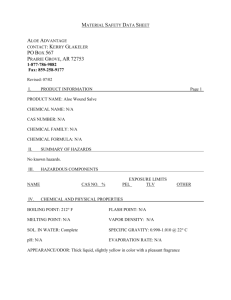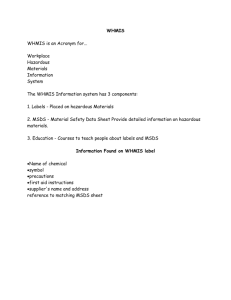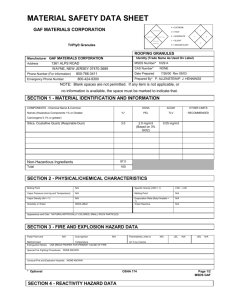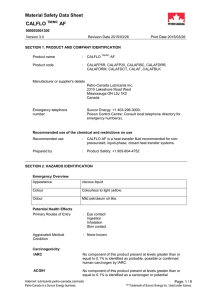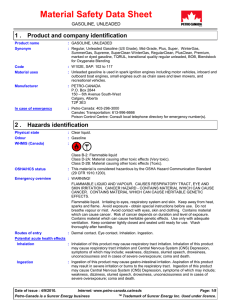Peerless LLG
advertisement
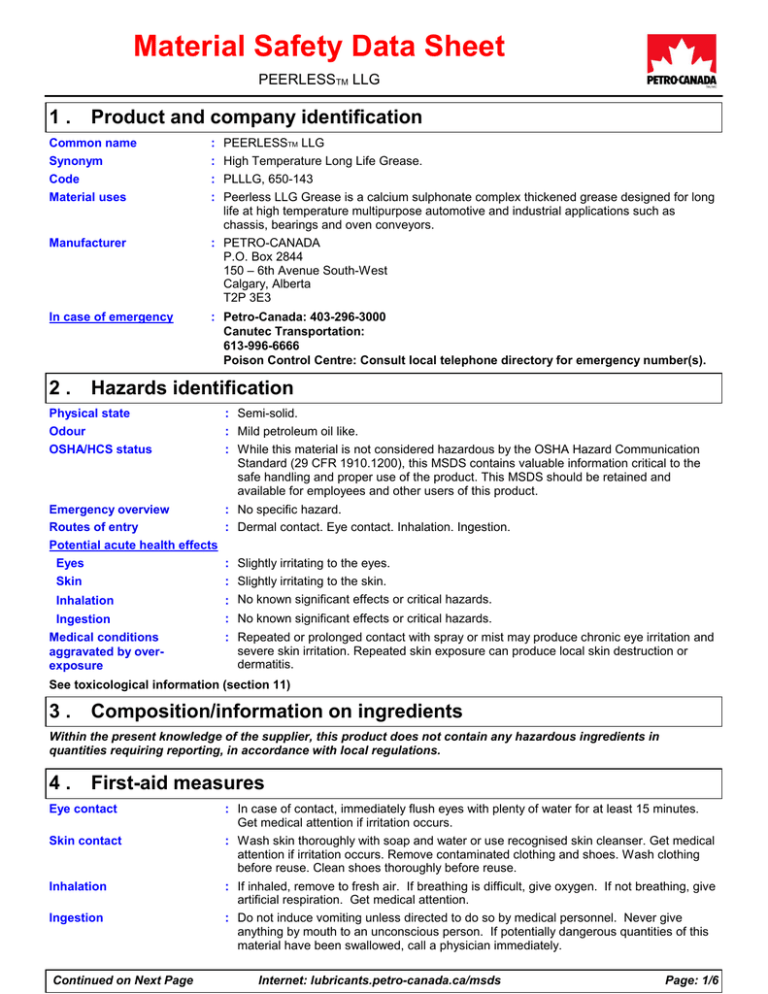
Material Safety Data Sheet PEERLESSTM LLG 1. Product and company identification Common name Synonym Code Material uses : : : : Manufacturer : PETRO-CANADA P.O. Box 2844 150 – 6th Avenue South-West Calgary, Alberta T2P 3E3 In case of emergency : Petro-Canada: 403-296-3000 Canutec Transportation: 613-996-6666 Poison Control Centre: Consult local telephone directory for emergency number(s). 2. PEERLESSTM LLG High Temperature Long Life Grease. PLLLG, 650-143 Peerless LLG Grease is a calcium sulphonate complex thickened grease designed for long life at high temperature multipurpose automotive and industrial applications such as chassis, bearings and oven conveyors. Hazards identification Physical state Odour OSHA/HCS status : Semi-solid. : Mild petroleum oil like. : While this material is not considered hazardous by the OSHA Hazard Communication Standard (29 CFR 1910.1200), this MSDS contains valuable information critical to the safe handling and proper use of the product. This MSDS should be retained and available for employees and other users of this product. Emergency overview Routes of entry Potential acute health effects Eyes Skin : No specific hazard. : Dermal contact. Eye contact. Inhalation. Ingestion. Inhalation Ingestion Medical conditions aggravated by overexposure : Slightly irritating to the eyes. : Slightly irritating to the skin. : No known significant effects or critical hazards. : No known significant effects or critical hazards. : Repeated or prolonged contact with spray or mist may produce chronic eye irritation and severe skin irritation. Repeated skin exposure can produce local skin destruction or dermatitis. See toxicological information (section 11) 3. Composition/information on ingredients Within the present knowledge of the supplier, this product does not contain any hazardous ingredients in quantities requiring reporting, in accordance with local regulations. 4. First-aid measures Eye contact Skin contact Inhalation Ingestion Continued on Next Page : In case of contact, immediately flush eyes with plenty of water for at least 15 minutes. Get medical attention if irritation occurs. : Wash skin thoroughly with soap and water or use recognised skin cleanser. Get medical attention if irritation occurs. Remove contaminated clothing and shoes. Wash clothing before reuse. Clean shoes thoroughly before reuse. : If inhaled, remove to fresh air. If breathing is difficult, give oxygen. If not breathing, give artificial respiration. Get medical attention. : Do not induce vomiting unless directed to do so by medical personnel. Never give anything by mouth to an unconscious person. If potentially dangerous quantities of this material have been swallowed, call a physician immediately. Internet: lubricants.petro-canada.ca/msds Page: 1/6 PEERLESSTM LLG 4. First-aid measures Protection of first-aiders 5. Page Number: 2 : No action shall be taken involving any personal risk or without suitable training. It may be dangerous to the person providing aid to give mouth-to-mouth resuscitation. Fire-fighting measures Flammability of the product Products of combustion Extinguishing media Suitable Not suitable Special exposure hazards : May be combustible at high temperature. : Carbon oxides (CO, CO2), sulphur oxides (SOx), calcium oxides (CaOx), smoke and irritating vapours as products of incomplete combustion. : Use an extinguishing agent suitable for the surrounding fire. : None known. : In a fire or if heated, a pressure increase will occur and the container may burst. Promptly isolate the scene by removing all persons from the vicinity of the incident if there is a fire. No action shall be taken involving any personal risk or without suitable training. Special protective equipment for fire-fighters : Fire-fighters should wear appropriate protective equipment and self-contained breathing apparatus (SCBA) with a full face-piece operated in positive pressure mode. Special remarks on fire hazards : Low fire hazard. This material must be heated before ignition will occur. Special remarks on explosion hazards : Do not pressurise, cut, weld, braze, solder, drill, grind or expose containers to heat or sources of ignition. 6. Accidental release measures Personal precautions : No action shall be taken involving any personal risk or without suitable training. Evacuate surrounding areas. Keep unnecessary and unprotected personnel from entering. Do not touch or walk through spilt material. Avoid breathing vapour or mist. Provide adequate ventilation. Wear appropriate respirator when ventilation is inadequate. Put on appropriate personal protective equipment (see section 8). Environmental precautions : Avoid dispersal of spilt material and runoff and contact with soil, waterways, drains and sewers. Inform the relevant authorities if the product has caused environmental pollution (sewers, waterways, soil or air). Methods for cleaning up : Stop leak if without risk. Move containers from spill area. Approach the release from upwind. Prevent entry into sewers, water courses, basements or confined areas. Wash spillages into an effluent treatment plant or proceed as follows. Contain and collect spillage with non-combustible, absorbent material e.g. sand, earth, vermiculite or diatomaceous earth and place in container for disposal according to local regulations (see section 13). Dispose of via a licensed waste disposal contractor. Contaminated absorbent material may pose the same hazard as the spilt product. Note: see section 1 for emergency contact information and section 13 for waste disposal. 7. Handling and storage Handling : Keep away from heat. Keep away from sources of ignition. Empty containers pose a fire risk. Evaporate the residue under a fume hood. Ground all equipment containing material. Do not ingest. Do not breathe gas/fumes/vapour/spray. Wear suitable protective clothing. If ingested, seek medical advice immediately and show the container or the label. Keep away from incompatibles. Storage : Keep container tightly closed. Store away from incompatible materials (see section 10). Keep container in a cool, well-ventilated area. 8. Exposure controls/personal protection Consult local authorities for acceptable exposure limits. Engineering measures : No special ventilation requirements. Good general ventilation should be sufficient to control worker exposure to airborne contaminants. If this product contains ingredients with exposure limits, use process enclosures, local exhaust ventilation or other engineering controls to keep worker exposure below any recommended or statutory limits. Continued on Next Page Internet: lubricants.petro-canada.ca/msds Page: 2/6 PEERLESSTM LLG 8. Page Number: 3 Exposure controls/personal protection Personal protection Eyes : Safety eyewear complying with an approved standard should be used when a risk assessment indicates this is necessary to avoid exposure to liquid splashes, mists or dusts. Skin : Personal protective equipment for the body should be selected based on the task being performed and the risks involved and should be approved by a specialist before handling this product. Respiratory : Use a properly fitted, air-purifying or air-fed respirator complying with an approved standard if a risk assessment indicates this is necessary. Respirator selection must be based on known or anticipated exposure levels, the hazards of the product and the safe working limits of the selected respirator. Recommended: organic vapour filter Hands : Chemical-resistant, impervious gloves complying with an approved standard should be worn at all times when handling chemical products if a risk assessment indicates this is necessary. Recommended: neoprene, nitrile, polyvinyl alcohol (PVA), Viton. Hygiene measures 9. : Wash hands, forearms and face thoroughly after handling chemical products, before eating, smoking and using the lavatory and at the end of the working period. Appropriate techniques should be used to remove potentially contaminated clothing. Wash contaminated clothing before reusing. Ensure that eyewash stations and safety showers are close to the workstation location. Physical and chemical properties Physical state Flash point Auto-ignition temperature Flammable limits Colour Odour pH Boiling/condensation point Pour Point Melting/freezing point Relative density Vapour pressure Vapour density Volatility Odour threshold Evaporation rate Viscosity Solubility LogKow Softening Point Dropping Point Penetration Physical/chemical properties comments Continued on Next Page : : : : : : : : : : : : : : : : : : : : : : : Semi-solid. Mineral Oil Blend: Open cup: 256°C (492.8°F) [Cleveland.] Mineral Oil Blend: Fire Point: 288°C (550.4°F) Not available. Burgundy Mild petroleum oil like. Not available. Not available. Mineral Oil Blend: -15°C (5°F) Not available. Mineral Oil Blend: 0.98 kg/L @ 15°C (59°F) Not available. Not available. Not available. Not available. Not available. Mineral Oil Blend: 100 cSt @ 40°C (104°F), 10.8 cSt @ 100°C (212°F), VI=98 Insoluble in water. Not available. Not available. 314°C (597°F) 284 @ 25°C (77°F) (60 strokes) Not available. Internet: lubricants.petro-canada.ca/msds Page: 3/6 PEERLESSTM LLG Page Number: 4 10 . Stability and reactivity Stability and reactivity Conditions of instability Incompatibility with various substances : The product is stable. : Not available. : Reactive with oxidising agents. Hazardous decomposition products : May release COx, SOx, CaOx, smoke and irritating vapours when heated to decomposition. Hazardous polymerisation : Under normal conditions of storage and use, hazardous polymerisation will not occur. 11 . Toxicological information Specific effects Carcinogenic effects Mutagenic effects Teratogenicity / Reproductive toxicity Sensitisation Ingestion Inhalation Eyes Skin Synergistic products : Not listed as carcinogenic by OSHA, NTP or IARC. : No known significant effects or critical hazards. : No known significant effects or critical hazards. : : : : : No known significant effects or critical hazards. No known significant effects or critical hazards. Slightly irritating to the eyes. Slightly irritating to the skin. Not available. 12 . Ecological information Ecotoxicity data Product/ingredient name Environmental precautions Bioconcentration factor BOD and COD Biodegradable/OECD Mobility Special remarks on the products of biodegradation Species Period Result : No known significant effects or critical hazards. Not available. Not available. Not available. Not available. Not available. 13 . Disposal considerations Disposal should be in accordance with applicable regional, national and local laws and regulations. Local regulations may be more stringent than regional or national requirements. The information presented below only applies to the material as supplied. The identification based on characteristic(s) or listing may not apply if the material has been used or otherwise contaminated. It is the responsibility of the waste generator to determine the toxicity and physical properties of the material generated to determine the proper waste identification and disposal methods in compliance with applicable regulations. Refer to Section 7: HANDLING AND STORAGE and Section 8: EXPOSURE CONTROLS/PERSONAL PROTECTION for additional handling information and protection of employees. Waste disposal Continued on Next Page : The generation of waste should be avoided or minimised wherever possible. Empty containers or liners may retain some product residues. This material and its container must be disposed of in a safe way. Dispose of surplus and non-recyclable products via a licensed waste disposal contractor. Disposal of this product, solutions and any byproducts should at all times comply with the requirements of environmental protection and waste disposal legislation and any regional local authority requirements. Avoid dispersal of spilt material and runoff and contact with soil, waterways, drains and sewers. Internet: lubricants.petro-canada.ca/msds Page: 4/6 PEERLESSTM LLG Page Number: 5 14 . Transport information Regulatory information UN number Proper shipping name Class PG* Label Additional information TDG Classification Not regulated. - - - - DOT Classification Not available. Not available. Not available. - - PG* : Packing group 15 . Regulatory information United States HCS Classification : Not regulated. Canada WHMIS (Canada) : Not controlled under WHMIS (Canada). This product has been classified in accordance with the hazard criteria of the Controlled Products Regulations and the MSDS contains all the information required by the Controlled Products Regulations. EU regulations Risk phrases International regulations International lists : This product is not classified according to EU legislation. : : : : Canada inventory status CHINA INVENTORY (IECS) EC INVENTORY (EINECS/ELINCS) TSCA 8(b) inventory Listed Listed Listed Listed 16 . Other information Hazardous Material Information System (U.S.A.) National Fire Protection Association (U.S.A.) : Health 1 Fire hazard 1 Reactivity 0 Personal protection B : Flammability 1 Health 1 0 Instability Special References Date of printing Date of issue Date of previous issue Responsible name Version For Copy of (M)SDS : Available upon request. TM/MC Marque de commerce de Petro-Canada - Trademark : 11/20/2008. : 9/8/2008. : No previous validation. : Product Safety - JDW : 2 : The Canadian Controlled Products Regulations (CPR) (Under the Hazardous Products Act, part of the WHMIS legislation) only apply to WHMIS Controlled (i.e., hazardous) products. Therefore, the CPR and the 3-year update rule specified therein do not apply to WHMIS Non-Controlled products. Although this is true, customarily Petro-Canada reviews and updates Non-Controlled product MSDS if a customer requests such an update. These Non-Controlled product updates are given a lower priority than Controlled products but are handled as soon as practicable. If you would like to verify if the MSDS you have is the most current, or you require any further information, please contact: Internet: lubricants.petro-canada.ca/msds Continued on Next Page Internet: lubricants.petro-canada.ca/msds Page: 5/6 PEERLESSTM LLG Page Number: 6 16 . Other information Lubricants: Western Canada, telephone: 1-800-661-1199; fax: (780) 464-9564 Ontario & Central Canada, telephone: 1-800-268-5850 and (905) 822-4222; fax: 1-800201-6285 Quebec & Eastern Canada, telephone: 1-800-576-1686; fax: 1-800-201-6285 For Product Safety Information: (905) 804-4752 Notice to reader To the best of our knowledge, the information contained herein is accurate. However, neither the above-named supplier, nor any of its subsidiaries, assumes any liability whatsoever for the accuracy or completeness of the information contained herein. Final determination of suitability of any material is the sole responsibility of the user. All materials may present unknown hazards and should be used with caution. Although certain hazards are described herein, we cannot guarantee that these are the only hazards that exist. Continued on Next Page Internet: lubricants.petro-canada.ca/msds Page: 6/6

